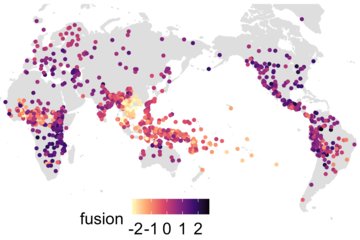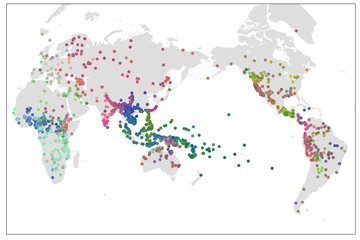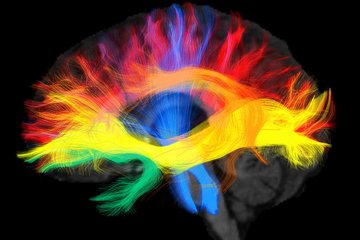Sound of words is no coincidence
Particular sounds are preferred or avoided in non-related languages far more often than previously assumed

N as in nose – an association that probably did not arise by chance. The sound n is found in the word for the olfactory organ more frequently than in other words. The same applies to the sound u; the sound a, on the other hand, is seldom found anywhere in the world. “Some words for particular concepts – as body parts – seem to have preferences towards carrying specific sounds in comparison to the rest of the words,” says Damián E. Blasi, a scientist from the Max Planck Institutes for Mathematics in the Sciences and for the Science of Human History. Blasi made a key contribution to a study in which a team of researchers, including scientists from Germany, the USA, Denmark and other countries, investigated the associations between sound and meaning in words.
The scientists used data for the study from over two-thirds of the 6,000-plus languages spoken throughout the world. “That is practically all of the available data,” says Peter F. Stadler, Professor at the University of Leipzig and academic staff member at the Max Planck Institute for Mathematics in the Sciences. Using the data pool of 4,000-plus languages, the researchers examined whether 100 words use certain sounds more frequently or more rarely than would be normal based on arbitrary association.
They actually discovered such positive and negative associations in languages that are not related to each other for many of the examined words. For example, the sounds o, u, p, k and q arise frequently in the words used for ‘knee’. The term ‘tongue’ has an e and l in many languages but rarely has a u or a k. These associations are not limited to parts of the body: the word used to denote ‘sand’ throughout the world often contains the sound s, and the sound t is frequently found in the words used for ‘stone’. “According to our analysis, certain sounds are preferred or avoided in a large proportion of all words across continents and language families and, moreover, by people from very different cultural, historical and geographical contexts,” says Damián Blasi. “In view of the enormous possibilities that exist for variations in the world’s languages, the result is astonishing and alters our understanding of the boundary conditions under which people communicate.”
Most people assume a bouba is a big animal, and a kiki small one
“Up to now, we assumed that such associations between sounds and meanings are very rare,” says Harald Hammarström, a linguist from the Max Planck Institute for the Science of Human History in Jena. In addition to the sound m in words denoting mother, linguists are also familiar with the bouba-kiki effect: they observe this phenomenon when they show someone a large animal like an elephant and a small one, for example a bird, and ask them which of the animals is called bouba, and which kiki in a language they do not know. Most people intuitively select bouba for the elephant and kiki for the small bird. The vowels a and o tend to be associated more with large things and e and i with small ones. However, this was practically the only known association of this kind that extends across language families.
Linguists could also have reached the view that meanings mostly came to be associated with their sounds randomly, as the available studies did not allow any other conclusion. “Previous studies were mostly limited to individual associations or a limited sample of languages,” explains Damián Blasi. “Thanks to the large volume of data we analyzed, we were also able to establish the spatial distribution of these associations and how they change over time.”
Using bioinformatics tools developed by Peter F. Stadler, the team of researchers discovered the fact that the associations are far more common than previously assumed. A mathematician, Stadler usually uses statistical instruments to discover genetic correlations in biology. “I kind of stumbled into the area of linguistics,” says Stadler. There are similarities but also differences between bioinformatics and linguistics, and he adapted the mathematical formulas to them.
Tests for statistical artefacts
In addition, Peter F. Stadler, Damián Blasi and their colleagues amassed all of the factors that could have an influence on the associations between sounds and meanings, but did not support the premise that some sounds are preferred or avoided for certain meanings throughout the world. Then they developed statistical tests to eliminate such artefacts. Genealogical relationships between languages are such a factor. They can result in the same sound-meaning relationships arising in different languages. However, the researchers had to exclude these cases, as they were only interested in the sounds that are preferred or avoided in words that are used in non-related languages.
The scientists also tested whether individual sounds arise more frequently in a term because the corresponding word was adopted by one language from another unrelated one spoken in a neighbouring region. Word length also played a role in the analysis: the longer a word is, the more likely that individual sounds will arise in it. “That would also give rise to a statistical artefact,” says Damián Blasi.
Search for original language becoming more difficult
Using similar statistical studies, the international team also looked for possible reasons why some sounds are chosen more often for a particular term than others. “We have been unable to explain the associations between sounds and meanings up to now,” says Harald Hammarström. The team reached its conclusion with the help of statistical tests for certain causes. For example, it has been conjectured, that words with certain sounds for a particular meaning can easily spread from one language to another if this combination is generally perceived as being suitable and pleasant. If this is the case, it must be possible to see how this spreads from a starting point into neighbouring language communities on a map showing the distribution areas of individual sound-meaning associations. The researchers found as little evidence for this as they did for the influence of a hypothetical original language, whose existence can possibly still be felt in many of today’s languages. If it existed, the associations between sounds and meanings in the different languages would have to be distributed in a similar pattern to related words. This is not the case, however.
“These insights into sound-meaning relationships have far-reaching consequences for linguistics,” says Damián Blasi. Particularly for the analysis of relationships between languages and the search for the original language. In such studies, linguists have also been searching for sounds that are associated with one word in different languages. “But we are raising a warning flag here,” says Peter F. Stadler. It appears that people associate many terms with the same sounds, irrespective of whether their languages are related to each other or not.
PH












